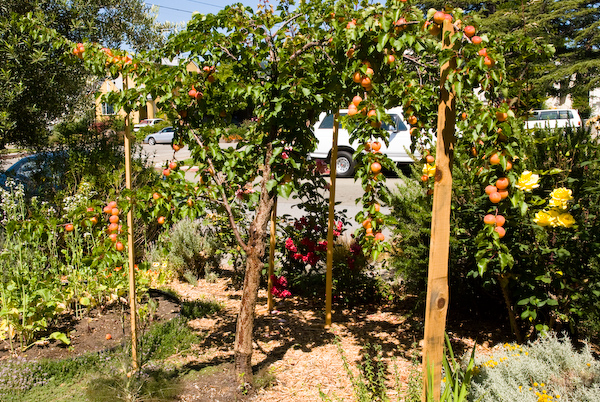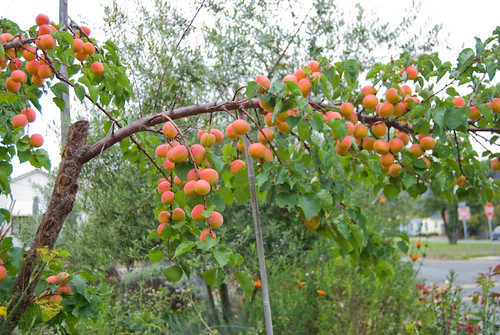Posts Tagged: urban farming
First of the 2009 harvest
We’ve had a few things from the garden so far this year, although it has been rather a disappointing one so far. A couple other people I talked to reported the same thing: things just didn’t seem to grow much through the spring. In my case, peppers, eggplant, basil and even some radishes, just didn’t really do anything. My guess is that we had too much fog this spring. (Never mind that today begins a little NorCal heatwave.)
Some other things, however, are doing fine. I have already dried about a quart and a half of Greek oregano. Many, many years ago my mom managed to bring back some oregano shoots from Greece and planted them at the house in Fresno. I had forgotten all about that, But when we were moving her up to the bay area, one of the things I noticed was a scraggly clump of oregano way in the back of the yard, past the grapevines. I was pretty sure this was the stuff from Greece, so I dug it up and planted it in my garden here. It is definitely different from the leafy stuff you get that the nurseries here. The leaves are very small, usually sparse, on long leggy stems. I understand that the Greeks don’t use the leaves much. They cut the stems when they are loaded with unopened flower buds and dry the buds. It is intensely aromatic. Maybe commercial oregano here is done the same way. I don’t really know.
The fruit trees are all happy this year, and of course the first crop to come in is the apricots. The tree got pretty loaded with fruit again this year, and again I couldn’t bring myself to thin it. But I was determined to avoid broken branches this year, so, I made some supports. It looks kinda greek hillbilly but it gets the job done. I think I’ll have enough for a few pints of jam.
Urban Farming
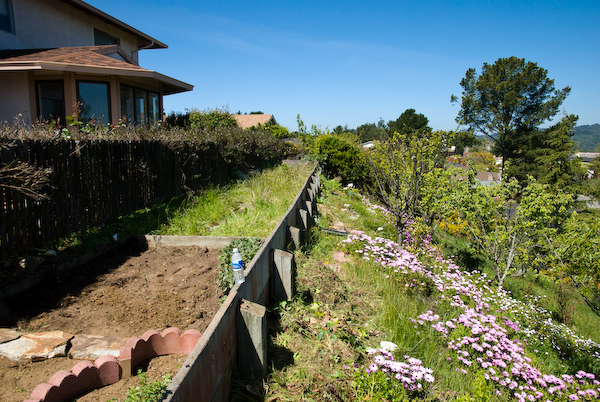
“In Aglaia’s Garden 5”, originally uploaded by neocles.
Spring is definitely here, and this week I have earnestly begun plans for spring planting. The difference this year is that in addition to planting my own small garden, I have been talking with my cousin Aglaia about collaborating on a more ambitious garden at her place where she has lots of space. I have been looking into urban farming ideas and the possibility of growing enough to trade with other local “farmers”.
Aglaia’s place is on the ridge in the Oakland hills on an eastern facing slope. It’s a great spot overlooking Moraga and the hills. Right now there is a strip at the top for vegetables, and many fruit trees on the slope. I will get the details on what trees there are, but I know there are at least a couple quince, which I love. And they are pretty rare around here these days, so Bay Area foodies interested in making jam or trendy membrillo (quince paste) might want some.
There’s tons of clean-up and soil preparation to do, which we started on yesterday. Irrigation is in place but after some years of neglect, probably needs repair. We hope to have the first planting down the first week of May. We are definitely interested in sharing and trading. (Check out www.neighborhoodfruit.com) So, if anyone has recommendations on what to plant around here that people like but don’t already have tons of in their own gardens, let me know!
apricot saga
About the apricot. In 2003 or so, I went down to Dwight Way Nursery and found this Blenheim apricot. It is supposed to be a dwarf or semi-dwarf, I can’t quite remember which.
I knew that there was some challenges to growing stone fruit around here. I know that they like a good cold winter to set fruit well, and, of course we don’t get much of that around here. A couple days of frost here and there is about it. Also, I know some people with peaches who report that periodically large chunks of the tree die for no apparent reason. Probably a blight that likes the relative dampness.
I chose apricot for a couple reasons. First, I thought that the smallness of the fruit might make it more likely that it will ripen. Secondly, my father planted an apricot at the house we moved to when I was five years old. That was a fabulous tree. It had a wonderful shape, an incredible crop almost every year, and the memory of it reminds me of my father. It lived for over 30 years until the renters i had in the house killed it and almost all the other fruit trees in the back yard through a couple fresno summers with no watering whatsoever.
In any case, my apricot produced no fruit the first season, about six or eight fruits the next couple seasons, and about a dozen last season. My friend Rocky had become fond of teasing me about the size of the cobbler he would be limited to in trying to do something with the “annual crop”. And last year, when the tree started the growing season with a perfectly balanced, bowl shape, and good new growth and budding, it suffered the mysterious die-back. One major branch on one side and a couple nearby small branches suddenly quit leafing, shriveled up, and died. The rest of the tree was basically okay, but it was misshapen and unbalanced. I put off my hopes to this year for both fruit and a return to form.
This year, there was not much weather during the spring. No hail, wind, or much rain came along to knock the beautiful blossoms from the tree. As the season progressed there was not a lot of new wood growth–not the several feet that previous years had seen. But it soon became obvious that there was a lot of fruit on the tree.
Around June 1st or so, my Neighbor Hugo said to me as we were admiring the tree, “you might get some 2x4s under a couple of those branches for support. You wouldn’t want them to break.” Well, I didn’t think this was much of a possibility. The aforementioned Fresno apricot never broke a branch no matter how laden with fruit. But after a couple of days, I took it more seriously, seeing that this young tree’s branches were still slender and there was a lot of fruit on them. What had been a narrow upright shape had now settled out into an open bowl of a branch structure. I propped them up with several bamboo sticks I had around.
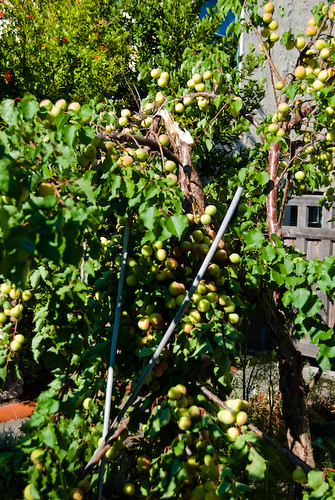
Then about a week later, we had a very windy night. I came out in the morning to find the largest branch of the tree broken, taking down about six feet of height from the tree and several pounds of not yet ripe fruit. I tried to salvage the fruit. Some, I picked and tried to ripen in a paper bag. Much of it I left on the broken branch in the hopes that what was left in the branch would continue to feed the fruit until it could ripen more. Each approach had success rate of about 2% of the fruit involved.
I was pretty disappointed, but there was still an incredible amount of fruit on the tree, so I got over it.
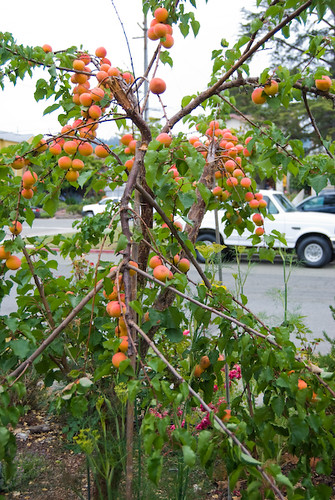
Then the other shoe dropped. About two weeks ago, not one, but two branches on the other side broke, despite being supported. There was a about 10 lbs. or more of fruit that had to be brought in. Fortunately, it was much closer to being ripe. I ripened much of it, and began eating it. As we did what was left on the tree, still a lot, was ripening and being brought in.
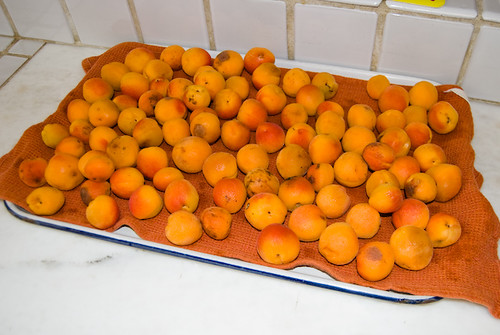
The past week we have been eating apricots like crazy. I gave some to Hugo next door. I gave some to my mom. We brought a bag to Fresno over the holiday. I made about four pints of preserves. I brought some to work. And still, we have a several pounds to pick and finish off the crop.

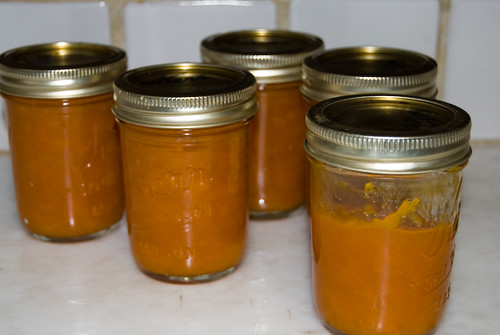
The lingering question is what the broken limbs mean for winter pruning, next spring growth, and the general shape and health of the tree. Only time will tell.

